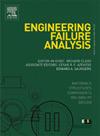Solder joint lifetime model using AI framework operating on FEA data
IF 4.4
2区 工程技术
Q1 ENGINEERING, MECHANICAL
引用次数: 0
Abstract
The thermo-mechanical reliability of electronic systems is often limited by the crack growth within the solder joints. Addressing this issue requires careful consideration of the design of the package and solder pads. Finite Element Analysis (FEA) is widely used to predict crack growth and to model their lifetime. Traditionally, FEA post-processing methods rely on human expertise to select appropriate regions for evaluating plastic and creep strain at critical locations and correlating these values with experimental data using the Coffin-Manson equation, which predicts fatigue lifetime based on cyclic plastic strain. This study introduces a novel method for FEA post-processing of surface-mounted devices (SMD) on printed circuit boards (PCB) using artificial intelligence. The method transforms the FEA data into a 2D grid map of creep strain values and employs a Convolutional Neural Network (CNN) for automatic feature extraction. Afterwards, a fully connected layer correlates the extracted features with the experimental measured solder joint lifetime, effectively capturing nonlinear relationships.
The study focuses on the development of the concept of crack formation in the solder interconnects of ceramic based high-power LED packages used in the automotive industry for headlights. The validated FEA model is based on an extensive data set of 1800 LED packages including seven different ceramic-based LED packages and five different solders. The design of the ceramic LED package covers two-pad and three-pad footprint for soldering and thin film and thick film metallized ceramic carriers. Results show a strong agreement (R2 Score is 99.867 %) between simulations and experimental data for ceramic LED packages. This automatic feature extraction from FEA data sets a new benchmark for improving solder reliability predictions, and it has proved to be better than established methods for lifetime prediction of solder joints.
使用基于有限元分析数据的人工智能框架建立焊点寿命模型
电子系统的热机械可靠性往往受到焊点裂纹增长的限制。要解决这个问题,就必须仔细考虑封装和焊盘的设计。有限元分析 (FEA) 被广泛用于预测裂纹的生长并建立其寿命模型。传统的有限元分析后处理方法依赖于人类的专业知识来选择适当的区域,以评估关键位置的塑性应变和蠕变应变,并使用 Coffin-Manson 方程将这些值与实验数据关联起来,该方程根据循环塑性应变预测疲劳寿命。本研究介绍了一种利用人工智能对印刷电路板(PCB)上的表面安装器件(SMD)进行有限元分析后处理的新方法。该方法将有限元分析数据转换为蠕变应变值的二维网格图,并采用卷积神经网络(CNN)进行自动特征提取。之后,一个全连接层将提取的特征与实验测量的焊点寿命相关联,从而有效地捕捉非线性关系。该研究的重点是开发汽车行业前大灯使用的基于陶瓷的大功率 LED 封装的焊料互连中裂纹形成的概念。经过验证的有限元分析模型基于 1800 个 LED 封装的广泛数据集,其中包括 7 种不同的陶瓷 LED 封装和 5 种不同的焊料。陶瓷 LED 封装的设计涵盖用于焊接的双焊盘和三焊盘基底以及薄膜和厚膜金属化陶瓷载体。结果表明,陶瓷 LED 封装的模拟和实验数据之间具有很高的一致性(R2 分数为 99.867 %)。这种从有限元分析数据中自动提取特征的方法为提高焊点可靠性预测设定了新的基准,而且事实证明它优于现有的焊点寿命预测方法。
本文章由计算机程序翻译,如有差异,请以英文原文为准。
求助全文
约1分钟内获得全文
求助全文
来源期刊

Engineering Failure Analysis
工程技术-材料科学:表征与测试
CiteScore
7.70
自引率
20.00%
发文量
956
审稿时长
47 days
期刊介绍:
Engineering Failure Analysis publishes research papers describing the analysis of engineering failures and related studies.
Papers relating to the structure, properties and behaviour of engineering materials are encouraged, particularly those which also involve the detailed application of materials parameters to problems in engineering structures, components and design. In addition to the area of materials engineering, the interacting fields of mechanical, manufacturing, aeronautical, civil, chemical, corrosion and design engineering are considered relevant. Activity should be directed at analysing engineering failures and carrying out research to help reduce the incidences of failures and to extend the operating horizons of engineering materials.
Emphasis is placed on the mechanical properties of materials and their behaviour when influenced by structure, process and environment. Metallic, polymeric, ceramic and natural materials are all included and the application of these materials to real engineering situations should be emphasised. The use of a case-study based approach is also encouraged.
Engineering Failure Analysis provides essential reference material and critical feedback into the design process thereby contributing to the prevention of engineering failures in the future. All submissions will be subject to peer review from leading experts in the field.
 求助内容:
求助内容: 应助结果提醒方式:
应助结果提醒方式:


